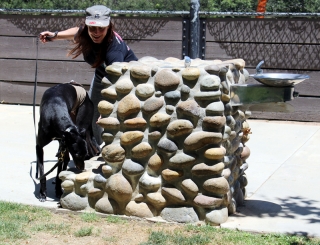How Nose Work Classes Helped to Rehabilitate my Dog-Reactive Greyhound

Judging from the scars all over his body, and the chunks of skin missing from both ears, my retired racing greyhound, Niki, must have been quite a target for the other dogs at the greyhound track he was rescued from. It’s not a stretch to understand why he was so dog-reactive. As a dog trainer for more than twenty-five years, I’ve seen quite a bit of reactivity, but none as wild as Niki’s. He would flip, spin, bark, lunge, growl and in general cause quite a scene at the sight of a dog from any distance away. From a cosmetic standpoint he is “funny looking” at best. His face is deformed, his jaws don’t meet and his lower teeth stick out at all times, not at all like the majority of gorgeous regal greyhounds. Reactive, deformed and black in color, his chances of getting adopted were not good but when I saw him I thought, “I’ll take two!” And so our journey began.
Prior to attending our first nose work class we began an intensive daily counter conditioning and desensitizing routine as we walked in our neighborhood. We worked on many positive protocols including “Open Bar”/“Closed Bar,” classical conditioning, B.A.T. set ups and the like. Gradually, over time he began to improve slightly and it’s been like “watching paint dry” as many of you know, but the paint is drying, thankfully.
Fast forward to our first canine nose work class. One of the many benefits of canine nose work is that the dogs are not allowed to interact or go nose-to-nose before, during or after class in order to keep them focused on the sport. All dogs are crated when it’s not their turn to work the scent field and only one dog works at a time. During the first round of classes Niki constantly barked in his crate, put on a big display if other dogs approached it and was hyper-vigilant when out of the crate. Through all of this, he managed to excel in the nose work searches and he moved on to straight birch by lesson five of the beginner class.
Our nose work progress mirrored his dog-reactivity progress. As we progressed through many classes from containers to vehicle searches, interiors, exteriors, multiple hides and odors, Niki’s behavior has progressed. With the help of the crates and the lack of strange dog greetings he stayed subthreshold most of the time and began to understand that he wasn’t going to get attacked. When the instructor wasn’t looking, we snuck in “forbidden” greetings and Niki made several friends in the class which is invaluable to me. I’m thrilled to report he can now attend “normal” dog events without creating a behavior tornado and is happy to “sit + watch” on walks when he sees another dog (except for that Welsh Springer Spaniel…) but marked improvement all around.
The combination of a positive reactivity protocol plus many rounds of interaction-free nose work sessions is a wonderful way to improve the quality of life for dog-reactive dogs. Thank you to the sport of nose work for welcoming all types of dogs, it’s so important because they aren’t all “perfect.” Thank you to my instructor, Penny Scott-Fox for her wisdom and patience and thank you to all of the other dog parents in class for working with us and celebrating Niki’s progress with me.
Next up? Passing an odor recognition test or two followed by an NW1 title? We’ll keep you posted!




